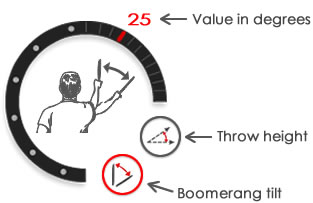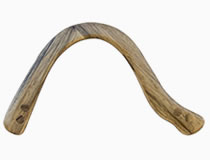Interface Elements

The boomerang used
Wind speed and direction indicator
Number of attempts made and points scored
Reference
Manipulator for setting the boomerang tilt and throw height
Manipulator for setting the force and direction of the throw
The boomerang used
This section (1) shows the boomerang with which the throw is made, its lifting force and category. The amount of lift is an important indicator. It is on him that you first need to focus when setting the parameters of the throw.
Wind speed and direction indicator
The wind speed varies from 0 to 10 meters per second. This is a conditional value. Other things being equal, a low wind speed will lead to a short flight, a high one to a flight.
Tilt and throw height manipulator
The manipulator adjusts two parameters: the height of the throw and the slope of the boomerang. The active parameter is highlighted in red.

To control it, you need to click the left mouse button on the manipulator area, and hold it, move it to the side. The value will change. You can also change the value with the mouse wheel.

Manipulator of the force and direction of the throw
The manipulator is shown as the corners of a red square. Located in the center of the field.

To control it, you need to click the left mouse button and hold it aside. The further away from the manipulator, the greater the force of the throw. When setting the direction, consider the perspective of the scene.

Game Management
To start the boomerang, you need to set 4 basic parameters:
tilt
throw height
force
direction
The combination of these parameters will determine which trajectory the boomerang will fly.
Tilt
The slope of the boomerang is set on the manipulator (5).

This is an important parameter. Set the angle of inclination taking into account the lifting force of the boomerang (1). For boomerangs with a large lift, a smaller angle is required and vice versa.
Throw height
The height of the throw is set on the manipulator (5). As a rule, a small horizontal angle is required for all boomerangs.

The landing point depends on this angle. Also, the height of the throw slightly affects the flight range.
The force of the throw
The force of the throw is set on the manipulator (6). An important parameter. Different boomerangs require a throw with different strength. It depends on the lifting force (1) of the boomerang and its weight. In general, for a heavy boomerang, a stronger throw is required. The weight in the game is not taken into account, so focus on the boomerang itself and its lifting force.
Direction
The direction of the throw is set on the manipulator (6). To make a throw, take into account the direction of the wind (2). The throw should be carried out approximately 45 degrees to the right of the wind. Deviations will cause the drop point to shift to the right/left.
The wind speed will also have an impact on the landing point. The stronger the wind, the more the boomerang will carry "behind" and vice versa.
How to play
Set the parameters of the throw, as if it were a real throw.
The first step is to adjust the angles of inclination and height of the throw.
The second step is to set the direction and strength. After that, a throw will be made.
In order for points to be awarded, the boomerang must leave the limits of the big circle and return. Points are awarded for hitting the corresponding radius, from 1 point, for touching a large circle, to 10 points for hitting the center.
Learn more about the points awarded.
Physics
The game does not implement the real physics of flight. The trajectory and behavior of the boomerang in flight are built approximately, based on observations and practical launches.
The parameters of the game, such as the lifting force of the boomerang, the wind speed and the force of the throw are conditional values.
Nevertheless, the final flight, taking into account the specified parameters, in many ways resembles the flight of a real boomerang.



